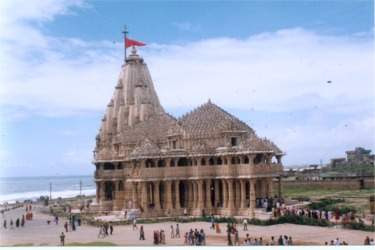Mahonnadham Mahakasam Mahodharam Mahabujam |
Mahavaktram Mallika arjunam Jyothi-swaroopam Namosthuthe ||
Andhra Pradesh, a state baking in the summer heart breaks into lush green carpeted landscape when the monsoons hit the parched lands. The Sri Sailam range has the Krishna River meandering through the foothills. There are places where the river flows inside the mountain, underground and is therefore called Patala Ganga. Legend has it that if one takes a dip in its sacred waters, they are blessed with amazing mind control and purity of thought. They say that even “manaseek darshan” (darshan through the mind) is also very effective here and bears fruit to one’s wishes.
Mallikarjuna is also known to be a Jyothir Linga sthala apart from hosting a Devi Peetham. It has its own share of mythologies surrounding it, in this case more than one event seem to have taken place in history, well beyond the measures of the western calendar.
Chandragupta ruled over a greater part of India, beyond the Northern banks of the Krishna River. He was a benevolent king who for the greater part of his life stayed away from the court fulfilling his royal duties. He had a very beautiful daughter, princess Chandravati who was very pious by nature. One day the princess when to the southern side of the Krishna River into the Sri Sailam forests to do penance. She was accompanied by a group of faithful herdsmen with cattle. She stayed in these forests for a while, and her main diet was milk from the cows.
One day she observed that her cow was not giving milk when the herdsman milked it. Curious to know the reason why, she ordered the herdsman to follow the cow wherever it went. The herdsman came back with news that the cow was yielding milk over a Manikam Shiva Linga (Linga made of Ruby). The princess went over and witnessed this for herself and was left pondering. That night Lord Shiva appeared in Jyotir Swarup in her dream and asked her to build a temple around this sacred Jyotir Linga. The princess built the temple according to the Lord’s instructions and the luminous Lord took the form of Shiva Mallikarjuna. This temple faces east and has a special shrine for Lord Brahma and Nandikeshwara occupies the central hall.
The Sthala puranam has another story to say. Lord Shiva and Parvati once decided to find suitable brides for their sons, Ganesha and Muruga who argued on who would get wedded first. Lord Shiva put the condition that the one who would go around the world in Pradakshinam would get married first. Lord Muruga took his vahana (vehicle), the peacock and flew away on his mission. Lord Ganesha held his hands together in adoration and walked around his parents 7 times. According to the Shastras, going round one’s parents in circumambulation is equal to going around the world in Bhupradakshinam. Having completed first, Lord Shiva got the daughters of Viswaroopan, Siddhi and Buddhi married to Ganesha.
When Muruga returned, he was enraged and went away to Mount Kravunja to stay alone there and assumed the title of Kumarabrahmachari (Bachelor). When Shiva and Parvati went to pacify him, he decided to move to another peak, but stayed back on request of the Devas. Lord Shiva and Parvati came to stay close at Sri Sailam. It is believed that Lord Shiva visits Muruga on Ammavasai and goes back to Parvati during Poornima.

Photo courtesy: Copyright © 1998-2001 Live India Internet Services!




